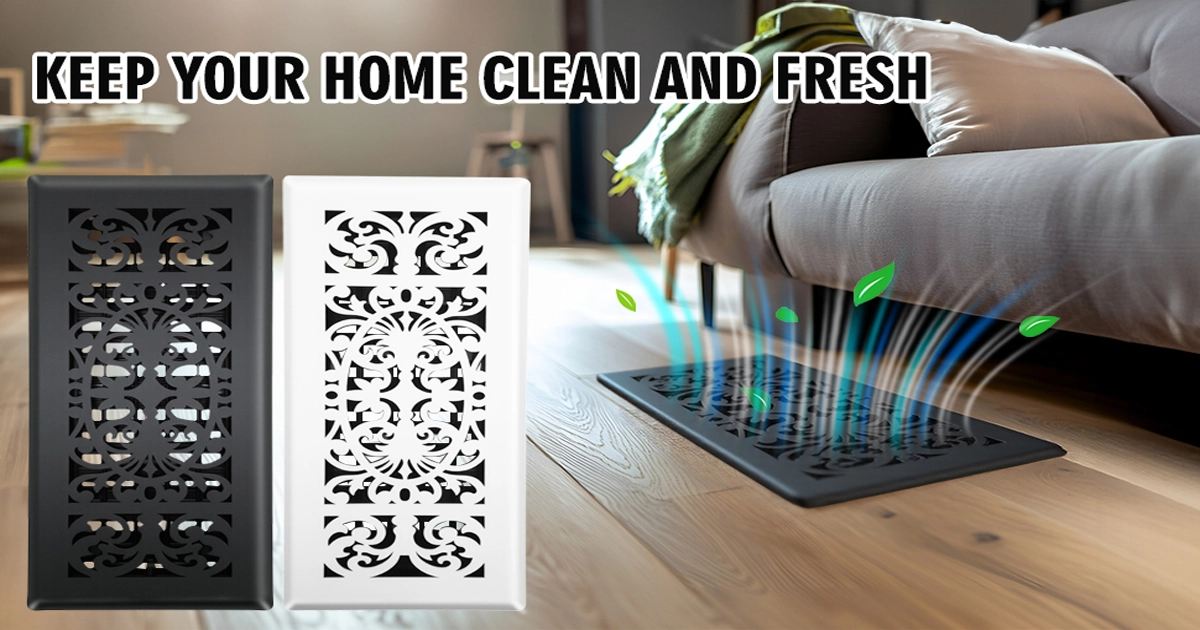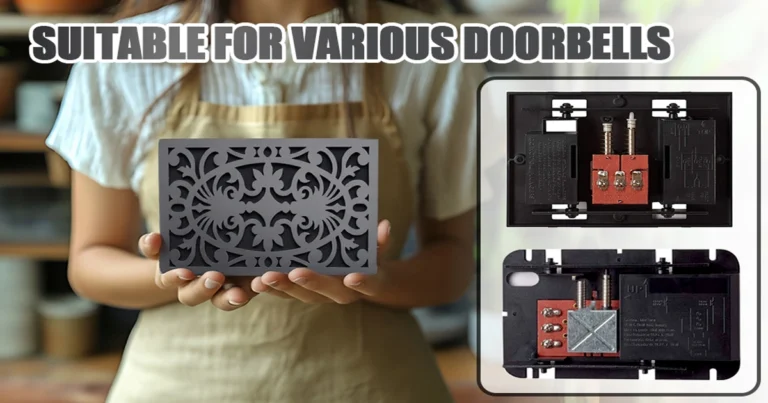How to Choose Decorative Vent Covers: A Homeowner’s Guide for 2025
Decorative vent covers offer a unique way to improve your home’s look, yet most people overlook them. These functional pieces can become beautiful design elements that come in many styles – from Moroccan to 3D Circular and Arabic patterns.
Most people think about big renovations to upgrade their homes. But swapping out basic vent covers can substantially change your interior design. These covers do more than just look good – they add architectural interest to walls and ceilings and help control airflow through the HVAC system. This piece will guide you through picking the right decorative vent covers that match your home’s style and keep proper ventilation. You’ll find options in metal, wood, and high-quality fiberboard that work perfectly for your space.
Table of Contents
Types of Decorative Vent Covers
The right material for vent covers plays a huge role in how they work and look. Let’s look at the most common decorative vent covers you can get for your home.
Metal vent covers
Metal vent covers are the top choice among homeowners. Cast aluminum covers give you the perfect mix of durability and style. They work great in high-traffic areas because they’re light yet tough . These covers won’t rust or corrode, which makes them a smart long-term investment.
Cast iron covers add a classic touch to traditional or vintage-style homes . Steel versions come with tough adjustable dampers and finishes that last for years . Aluminum grilles are your best bet for damp areas since they never rust .
Wood and fiberboard options
Wood vent covers bring natural warmth and character to any room. Craftsmen can make these covers from more than 50 different wood types . This gives you endless customization options. High-density machine board (HDM) is another great wood-based choice. You can prime and paint it easily, and it allows for detailed designs .
Wood covers really shine in:
- Wall and ceiling installations
- Custom cabinetry integration
- Interior architectural elements
- Toe kick vents
HDM wood covers are budget-friendly and you can paint them to match your home’s style perfectly .
Modern plastic designs
Modern plastic vent covers are newer additions to home ventilation. While not as common as metal or wood, plastic covers have their own benefits. You’ll often see these covers in bathroom vent fans, but they’re now used throughout homes .
Today’s plastic vent covers stand out with:
- Lightweight construction
- Cost-effectiveness
- Versatility in design options
- Easy maintenance
Each material works best in specific spots. Cast metal covers are perfect for floor vents because they’re so strong . Wood options look amazing on walls and ceilings where you can really see their natural beauty . Plastic versions are great where you need something light, though they might not last as long as metal ones.
Measuring and Sizing Your Vents
Accurate measurements play a significant part in selecting decorative vent covers that fit our spaces perfectly. The right measurement process will give a way to avoid common sizing mistakes before ordering new covers.
How to measure correctly
Start by removing the existing Decorative Floor Vent Cover from the opening. A utility knife helps score around old covers to prevent paint from peeling during removal. The actual duct opening needs measurement rather than the old cover because different covers have unique frame sizes.
To get precise measurements:
- Measure the length (horizontal) first, followed by the height (vertical)
- Round measurements to the nearest half-inch
- Double-check your measurements to confirm accuracy
New covers’ overall frame extends about 1 inch beyond the stack on each side. To name just one example, see a 10″ x 4″ duct opening that will need an 11.75″ x 5.75″ overall frame dimension.
Common vent sizes
Standard residential vent sizes range from 6″ x 6″ to 30″ x 18″. Most floor vents come with a 4″ x 10″ duct opening. Wall and ceiling installations typically use these sizes:
- 2.25″ x 10″ to 2.25″ x 14″
- 3″ x 10″ to 3″ x 14″
- 4″ x 8″ to 4″ x 14″
- 6″ x 10″ to 6″ x 30″
Custom outside dimensions might be needed for toe-kicks or areas near walls. More importantly, manufacturers usually undersize the stack dimensions by about 1/4 inch to ensure proper clearance and handle duct work variations.
Ceiling installations need mounting holes to attach securely. The cover’s face shows these countersunk screw holes, and the number of required screws changes based on the cover size to maintain proper security.

Style and Design Selection
Decorative vent covers now go beyond their simple functionality and provide design choices that will give a room more character. These covers act as subtle yet meaningful design elements, ranging from modern patterns to classic traditional motifs.
Modern patterns
Contemporary vent covers feature clean lines and geometric shapes. Modern esthetics favor matte black finishes and brushed nickel surfaces . Homeowners prefer flush-mount options that sit level with floors and walls, particularly in industrial or minimalist décor . The visual appeal comes from geometric patterns and nature-inspired motifs that add interest without dominating the space .
Traditional looks
Vintage-style vent covers bring timeless appeal through ornate grilles and detailed craftsmanship . Classic designs showcase antique finishes that add warmth and character to traditional interiors. Historical charm flows through Victorian-inspired patterns and mid-century elements . Arts and crafts styles are available to more people in cast aluminum, starting at $25.95 .
Custom designs
Laser etching technology makes customization available to more homeowners . You can pick from various finishes like oil-rubbed bronze, antique brass, and brushed stainless steel . Many manufacturers let you provide your own patterns or select from existing design collections .
Color matching tips
The 60-30-10 rule will give a balanced color integration throughout spaces . Living areas and entryways look more harmonious when vent covers match the room’s largest pattern . White covers blend naturally with white trim, while black options work best in modern, monochromatic schemes . Brown or tan finishes are a great match for rooms with wood paneling .
Paintable options from manufacturers help achieve perfect color matching with existing wall colors . Premium powder coating services let you access any color from standardized catalogs to match your interior design schemes precisely .
Installation and Maintenance
You can keep decorative vent covers working well and looking great with the right installation and regular upkeep. Everything in proper maintenance helps protect your investment and keeps air flowing smoothly.
DIY installation steps
You need just a few tools and simple DIY skills to install decorative vent covers. The original step involves removing the old cover with a screwdriver . A sheet placed underneath catches any debris during wall or ceiling installations . Getting precise measurements of the duct opening is vital for a proper fit .
Standard floor registers fit directly into the air duct opening . Wall and ceiling covers need secure mounting with screws through pre-drilled holes . Heavy-duty velcro strips work well for covers under 10 pounds .
Cleaning methods
Your vent covers stay pristine and maintain optimal airflow with regular cleaning. A vacuum with brush attachment or dry microfiber cloth works great for monthly cleaning . Take the covers off every six months to wash them thoroughly with mild soap and water .
Metal covers are dishwasher-safe, while wood or vinyl ones need specific floor cleaners . The covers must be completely dry before you put them back to avoid dust buildup . Stubborn grime comes off easily with rubbing alcohol without damaging the finish .
When to replace
Look out for these signs that show you need new vent covers:
- Louvers stuck in place and blocking airflow
- Damage from moving furniture or hoovering up
- Heavy blockage that regular cleaning won’t fix
- Rust taking over or broken parts
Wall vents usually need replacement once or twice a year . Ceiling vent covers last 15-20 years if maintained well . All the same, newer versions with antimicrobial features and better dust protection might be worth the upgrade .
Conclusion
Decorative vent cover show how simple functional elements can transform into stunning design features in our homes. The right material selection, precise measurements, and style choices can turn these overlooked components into elements that boost our living spaces substantially.
Metal covers provide durability and versatility. Wood options add natural warmth to interiors, while modern plastic alternatives give budget-friendly style options. The cover’s size must fit perfectly to work well, whatever material you choose.
Your success with White Decorative Floor Vent Cover comes down to good planning and regular care. A cover that matches your home’s style and stays well-maintained serves both practical and esthetic needs. These architectural elements need careful thought when upgrading homes, from sleek modern patterns to classic traditional designs.
FAQs
Q1. Should vent covers match the floor or walls? The choice of whether vent covers should match the floor, walls, or stand out as a design element depends on your personal preference and overall interior design goals. For a seamless look, you can match them to the largest pattern in the room or choose neutral colors that blend with your decor.
Q2. What are the best materials for decorative vent covers? The best materials for decorative vent covers depend on their location and your needs. Metal covers, particularly cast aluminum, are durable and suitable for high-traffic areas. Wood covers add warmth and character, while modern plastic designs offer lightweight and cost-effective options. For moisture-prone areas, aluminum is ideal due to its rust-resistant properties.
Q3. How do I measure for new vent covers? To measure for new vent covers, remove the existing cover and measure the actual duct opening, not the old cover itself. Measure the length (horizontal) first, then the height (vertical), rounding to the nearest half-inch. Remember that the new cover’s frame will extend about 1 inch beyond the opening on each side.
Q4. How often should I clean my vent covers? For optimal performance and appearance, clean your vent covers monthly using a vacuum with a brush attachment or wipe them with a dry microfiber cloth. Perform a deeper cleaning every six months by removing the covers and washing them with mild soap and water. Ensure they’re completely dry before reinstallation.
Q5. When is it time to replace my vent covers? Consider replacing your vent covers when you notice permanently stuck louvers, visible damage, severe obstruction despite regular cleaning, or significant rust development. Wall vents typically need replacement once or twice yearly, while ceiling vent covers can last 15-20 years with proper maintenance. You might also want to upgrade to newer versions with improved features like antimicrobial properties.


